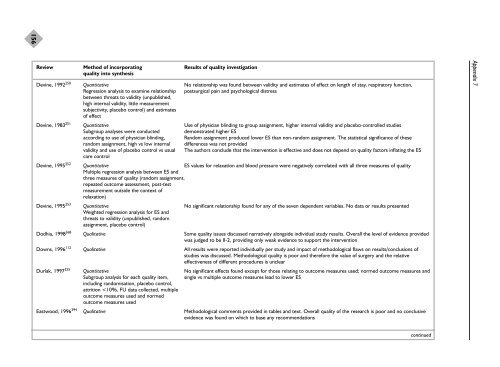Evaluating non-randomised intervention studies - NIHR Health ...
Evaluating non-randomised intervention studies - NIHR Health ...
Evaluating non-randomised intervention studies - NIHR Health ...
You also want an ePaper? Increase the reach of your titles
YUMPU automatically turns print PDFs into web optimized ePapers that Google loves.
156Review Method of incorporating Results of quality investigationquality into synthesisDevine, 1992 250 Quantitative No relationship was found between validity and estimates of effect on length of stay, respiratory function,Regression analysis to examine relationship postsurgical pain and psychological distressbetween threats to validity (unpublished,high internal validity, little measurementsubjectivity, placebo control) and estimatesof effectDevine, 1983 251 Quantitative Use of physician blinding to group assignment, higher internal validity and placebo-controlled <strong>studies</strong>Subgroup analyses were conducted demonstrated higher ESaccording to use of physician blinding, Random assignment produced lower ES than <strong>non</strong>-random assignment. The statistical significance of theserandom assignment, high vs low internal differences was not providedvalidity and use of placebo control vs usual The authors conclude that the <strong>intervention</strong> is effective and does not depend on quality factors inflating the EScare controlDevine, 1995 252 Quantitative ES values for relaxation and blood pressure were negatively correlated with all three measures of qualityMultiple regression analysis between ES andthree measures of quality (random assignment,repeated outcome assessment, post-testmeasurement outside the context ofrelaxation)Devine, 1995 253 Quantitative No significant relationship found for any of the seven dependent variables. No data or results presentedWeighted regression analysis for ES andthreats to validity (unpublished, randomassignment, placebo control)Dodhia, 1998 368 Qualitative Some quality issues discussed narratively alongside individual study results. Overall the level of evidence providedwas judged to be II-2, providing only weak evidence to support the <strong>intervention</strong>Downs, 1996 112 Qualitative All results were reported individually per study and impact of methodological flaws on results/conclusions of<strong>studies</strong> was discussed. Methodological quality is poor and therefore the value of surgery and the relativeeffectiveness of different procedures is unclearDurlak, 1997 255 Quantitative No significant effects found except for those relating to outcome measures used; normed outcome measures andSubgroup analysis for each quality item, single vs multiple outcome measures lead to lower ESincluding randomisation, placebo control,attrition
















